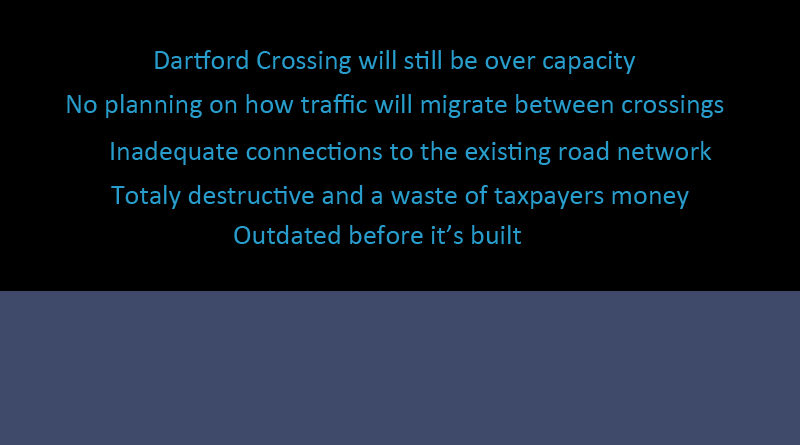Lower Thames Crossing is not fit for purpose
This article has now been updated – https://www.thamescrossingactiongroup.com/ltc-not-fit-for-purpose/
As we have mentioned previously, many will be under the impression that the proposed Lower Thames Crossing is about solving the congestion issues we all suffer due to the Dartford Crossing. However, it has become more and more apparent the more research you do into the proposed route that this simply is NOT the case. The proposed Lower Thames Crossing is not fit for purpose.
Tim Jones, who was LTC Project Director until he resigned in July 2019, had stated on numerous occassions that it will not solve all the problems we all suffer with due to the Dartford Crossing. If you missed that you can find out more here – www.thamescrossingactiongroup.com/it-wont-solve-dartford-crossing-issues/.
Some data that proves the Lower Thames Crossing is not fit for purpose
- The Dartford Crossing has a design capacity of 135,000 vehicles per day. (1)
- It is currently running at between 155,000 to 180,000 vehicles per day (2)(3)
- Predicted traffic growth between 2016 and 2026 is expected to be between 17-23% (2)(4). Bear in mind that currently the proposed Lower Thames Crossing is not predicted to open until late 2029/30.
- Highways England predict that there will be a 22% reduction in traffic using the Dartford Crossing if the proposed Lower Thames Crossing goes ahead. (5)
Therefore if you take each figure that the current crossing is running at now, add the 17%, 23%, or an average of 20%, then take the 22% reduction off this is what you get:
155,000+17%=181,350 / 181,350-22%= 141,453 vehicles per day using the Dartford Crossing
180,000+17%=210,600 / 210,600-22%= 164,268 vehicles per day using the Dartford Crossing
155,000+23%=190,650 / 190,650-22%= 148,707 vehicles per day using the Dartford Crossing
180,000+23%=221,400 / 221,400-22%= 172,692 vehicles per day using the Dartford Crossing
155,000+20%=186,000 / 186,000-22%= 145,080 vehicles per day using the Dartford Crossing
180,000+20%=216,000 / 216,000-22%= 168,480 vehicles per day using the Dartford Crossing
Clearly the Dartford Crossing would still be over it’s design capacity of 135,000 vehicles per day. The current cost of the proposed Lower Thames Crossing which will leave the Dartford Crossing still over capacity is £8.2bn+ of tax payers money. We all know these projects never run to budget, so that is a lot of money being spent on something that does not fulfil the original criteria of fixing the problems we all suffer with due to the Dartford Crossing. Clearly the proposed Lower Thames Crossing is not fit for purpose.
In addition
There are not adequate connections in place between the proposed Lower Thames Crossing and the existing road network. There are various posts on this website that explain, if you wish to learn more please check out some of the links of our Statutory Consultation Posts page.
Highways England have not planned how traffic will migrate between the two crossings when there is an incident. This will result in absolute chaos on the roads whenever there is an incident.
Also they are not, and do not have to, take into account the tens of thousands of new homes and developments in the region unless they have already been granted planning permission. This means tens of thousands of homes that form Local Plans in the region are not taken into account, including other developments and infrastructure that is being planned, unless it already has planning permission, which much of it doesn’t. This includes projects like the huge theme park that London Resorts are planning in Kent.
Ultimately the proposed Lower Thames Crossing would create a toxic triangle that destroys homes, greenbelt, ancient woodland, grade 1 agricultural land, wildlife habitats, communities and much more, all at a huge cost to British taxpayers.
The fact is the proposed Lower Thames Crossing is simply not fit for purpose.
List of links to references for quoted data
(1) Ref – Your Guide to Consultation (Page 20)
(2) Ref – 2017 Environmental Impact Assessment – Scoping Report (1.2.5)
1.2.5 – The existing crossing is heavily congested. Average daily two-way traffic flows are typically about 155,000 vehicles, and flows frequently exceed the design capacity of the crossing at peak periods. Forecast traffic growth is expected to result in an increase in traffic volume of 23% by 2025.
(3) Ref – Case for the Project (page 19)
6.2.32 – Traffic at the Dartford Crossing has increased significantly over time. On some days traffic using the Dartford Crossing exceeds 180,000 vehicles which is some 45,000 vehicles more than is was designed to take.
(4) Ref – Case for the Project (page 19)
6.2.37 – The average daily traffic flow using the Dartford Crossing without the Lower Thames Crossing is predicted to increase by 17% in the period 2016-2026.
(5) Ref – Your Guide to Consultation (page 22)

